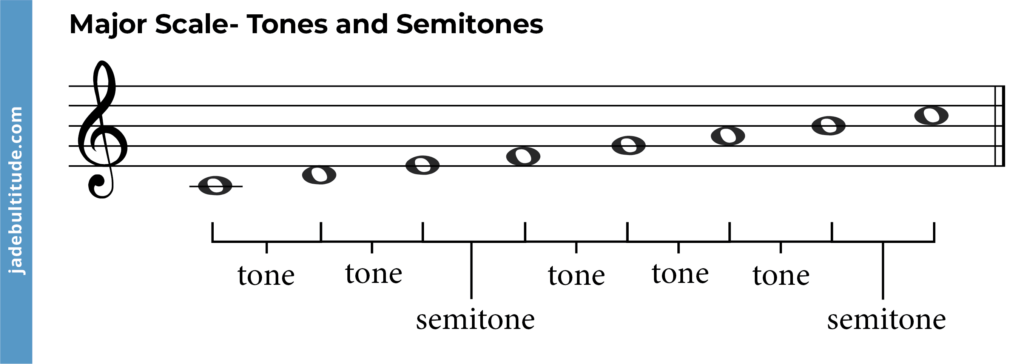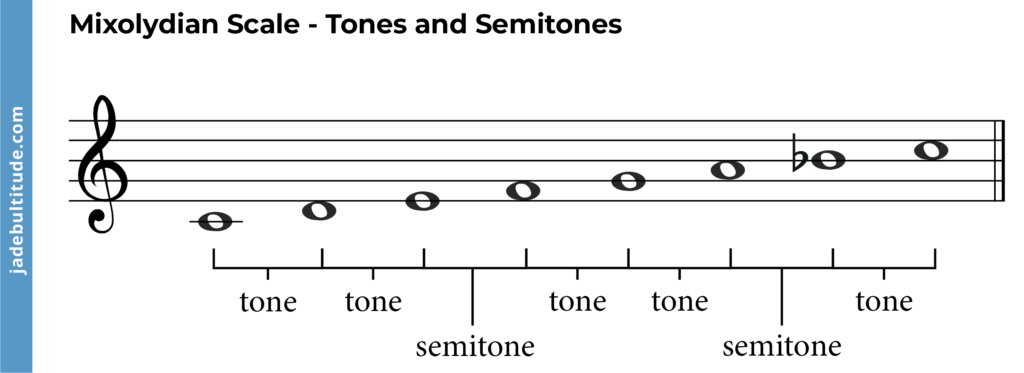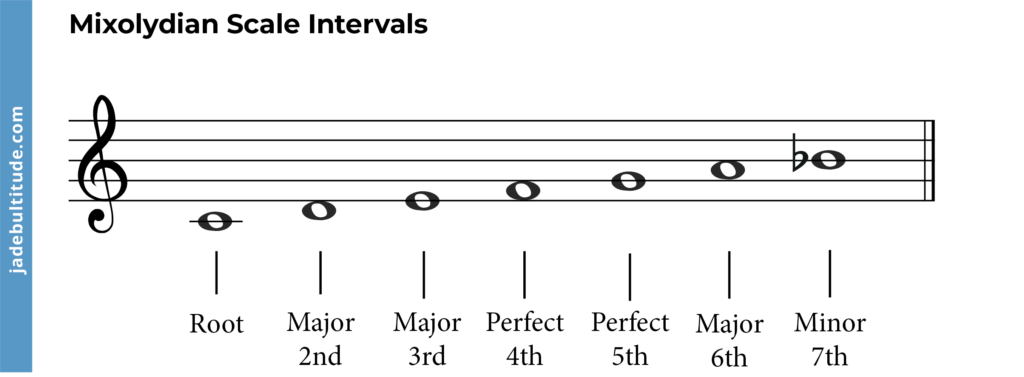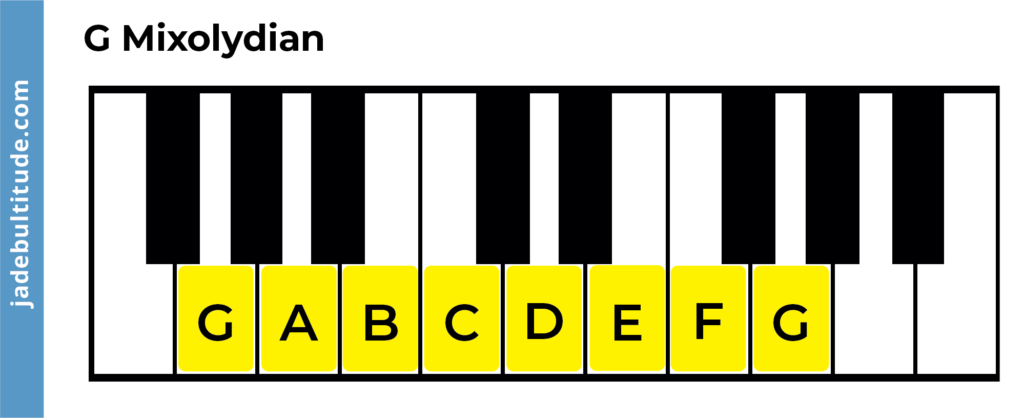There are many different scales in music and some are more common than others. You will have heard of major scales and the minor scales but the diatonic modes are something totally different. Before diving straight into the Mixolydian mode, here’s a quick summary how all the modes fit together.
What are musical modes and why are they important?
The musical modes are a series of seven diatonic scales based on the major scale. The modes are sometimes referred to as Greek Modes or modal scales in music theory.
In any given major key you can play all seven modes. Each of these modes will start on a different scale degree. As you can see all the different modes are very closely related.
If we look at the note sequence of the modes in the C major scale they will be as follows:
C D E F G A B C – C Ionian Mode
D E F G A B C D – D Dorian Mode
E F G A B C D E – E Phrygian mode
F G A B C D E F – F lydian mode
G A B C D E F G – G Mixolydian mode
A B C D E F G A – A Aeolian Mode
B C D E F G A B – B Locrian Mode
All the notes above use the notes from the C major scale.
What is the Mixolydian Mode?
The Mixolyian mode is a mode that starts on the fifth scale degree of a major scale. As we saw above, if you are in C major, the mixolyian scale will begin on G. G is the fifth degree of C major. It is the fifth mode of the seven modes.
If you are in the F major scale, the mixolydian mode will begin on C. C is the fifth degree of F major. The mode you create will then be the C Mixolydian scale.

If you are in the G major scale, the mixolydian mode will be begin on D. D is the fifth degree of G major. The mode you create will then be the D Mixolydian scale.

From Major Scale to Mixolydian Mode
As we have seen, the mixolydian mode can be created from the fifth degree of a major scale. Remember scale degrees just refer to the number note of the scale.
The pattern of whole step and half steps (semitones and Tones) in the major scale is as follows:
W W H W W W H (T T S T T T S)

As the mixolydian mode starts on the fifth degree of the major scale, this pattern will simply shift up.
The Mixolyian Scale Formula
The pattern of whole steps and half steps (semitones and Tones) in the mixolydian mode with therefore be as follows:
W W H W W H W (T T S T T S T)

Mixolydian Mode Scale Degrees
The aeolian mode is a major mode. This simply means that this mode has many of the same qualities as a major scale (ionian mode). In fact the only difference is the flattened seventh scale degree!
For a major scale to sound major, the third of the scale will be a major third. In the mixolydian mode, this third degree is a major third! This is what gives the scale it’s major quality.
The degrees in the mixolydian mode will be as follows:
- Root
- Major Second
- Major Third
- Perfect Fourth
- Perfect Fifth
- Major sixth
- Minor Seventh

How to Play the Mixolydian Scale
You can play the Mixolydian scale on any instrument. Whether you play the piano, guitar or flute all the modes will contain all the same notes on each instrument. All you must do is learn the notes of that particular mode. Once you are comfortable playing scales you can then begin to play all the modes!
For example, the G Mixolydian mode consists of all natural notes.
G A B C D E F G
Learn these notes and you can play it on any instrument. Below you can see the notes on the piano, notice how this scale uses only the white keys.

Here is the scale chart for playing the mixolydian mode on guitar. The root note is labelled in red and you can slide this shape up and down the neck to play different mixolydian scales.

Music Written in the Mixolydian Mode
The mixolydian mode is used most often in pop and jazz music. It has a very distinctive jazz and blues sound.
Take a listen to ‘All Blues‘ by Miles Davis.
There are also some examples in rock music, take a listen to ‘Dark Star’ by The Grateful Dead.
We also see use of the mixolydian mode in popular music, take a listen to ‘Clocks’ by Cold Play.
List of Mixolydian modes
Although the G Mixolydian scale is the easiest mode to create as it comes from the fifth note of the c major scale, meaning you only have to play the white keys on the piano, you can create a mixolydian scale on any note you like! As long you keep the same interval pattern you can create the mixolydian mode on any note. Each of the modes below have been created using the whole step and half step pattern we saw earlier.
C Mixolydian mode – C D E F G A Bb C
C# Mixolydian mode – C# D# E# F# G# A# B C#
Db Mixolydian mode – Db Eb F Gb Ab Bb Cb Db
D Mixolydian mode – D E F# G A B C D
D# Mixolydian mode – D# E# Fx G# A# B# C# D#
Eb Mixolydian mode – Eb F Gb Ab Bb C Db Eb
E mixolydian mode – E F# G# A B C# D E
F Mixolydian mode – F G A Bb C D Eb F
F# Mixolydian mode – F# G# A# B C# D# E F#
Gb Mixolyidan mode – Gb Ab Bb Cb Bb Eb Fb Gb
G Mixolydian mode – G A B C D E F G
G# Mixolydian mode – G# A# B# C# D# E# F# G#
Ab Mixolydian Mode – Ab Bb C Db Eb F Gb Ab
A Mixolydian mode – A B C# D E F# G A
Bb Mixolydian Mode – Bb C D Eb F G Ab Bb
B Mixolydian mode – B C# D# E F# G# A B
Which chord progressions can you use the Mixolydian scale with?
Mixolydian scale chord progressions are a series of chords derived from the mixolydian scale. To build a chord progression in the mixolydian scale you must first simply choose chords that can be created with these notes. The first place to start is to create a chord (triad) on every note of the chosen mixolydian mode. Below you can see a chord built on every note of the G mixolydian scale, notice that none of the notes have an accidental on and this is because the G mixolydian has no sharps or flats.
The modal chords of the Mixolydian mode

Each of these chords can then be labelled so you know what each chord is. If you need to learn more about these labels then make sure to check out our complete guide to chords.
We could all use Roman numeral notation to label each chord.

Chord I in the G mixolydian scale is a major chord as the interval between G and B is a major third. We will then label this chord with an upper case I to indicate that it is a major chord built on the root of the scale. Each chord can then be labelled in this way and we will then know which chords have a minor quality and which ones have a major quality!
If the chord has a major quality the third will be a major third and we will label this chord with capital Roman numerals and if the chord has a minor quality, the third will be a minor third and we will label this chord with lower case roman numerals.
When writing a chord progression it is always advisable to use the root chord first. This will establish the key you are in.
It is also worth noting that for all mixolydian scales the type or chords will remain the same. So the 1st chord will always be major, the 2nd will always be minor and so on…
Want to learn more?
To learn more about the other modes you can visit our pages on each mode here:
- Ionian mode
- Phrygian mode
- Lydian mode
- Dorian mode
- Aeolian mode
- Locrian mode

Fabulous Jade! Keep them coming.
Thank you! I am so glad you are finding the website useful!